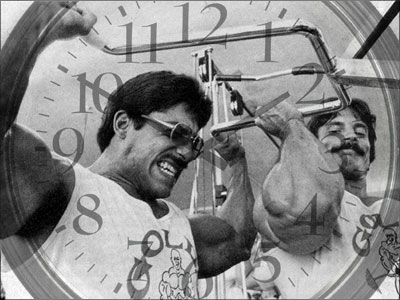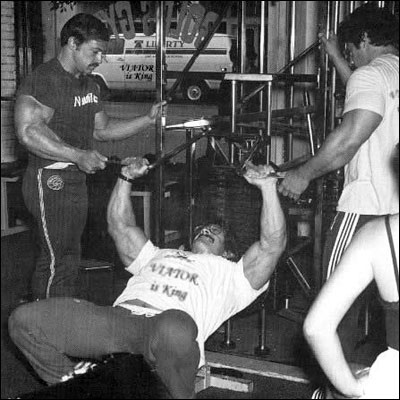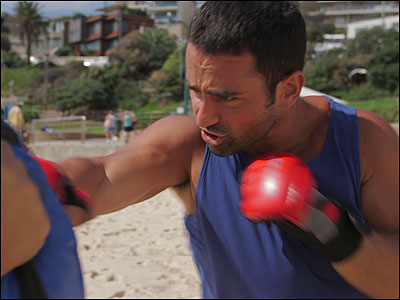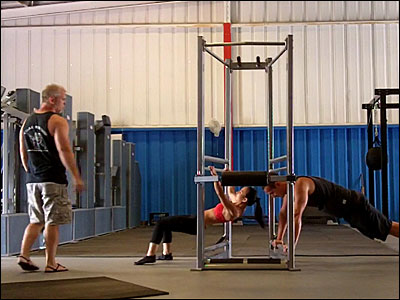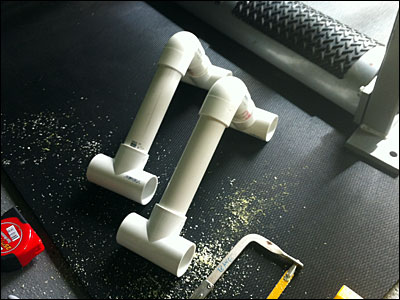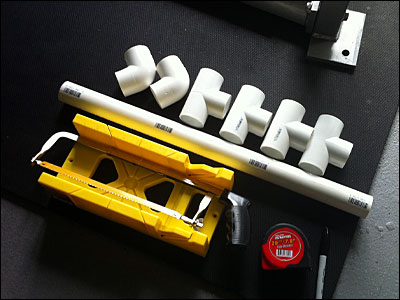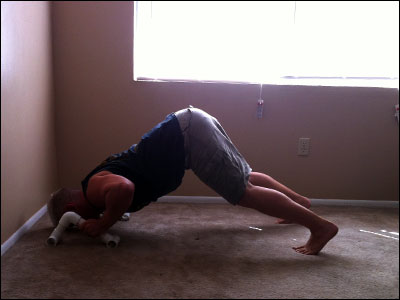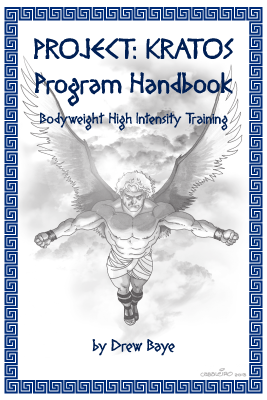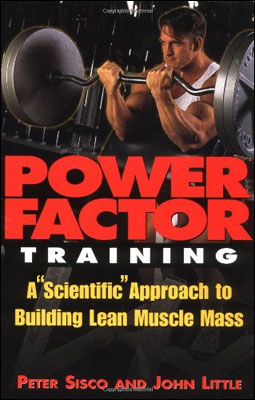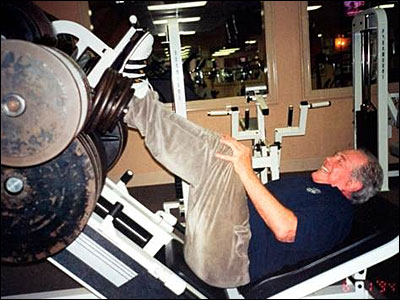The following is a case study by Dr. James Peterson, who was the Associate Professor of Physical Education at the United States Military Academy in West Point when Nautilus participated in several studies there known as Project: Total Conditioning. This originally appeared in Athletic Journal Vol. 56 in September of 1975.
This should be read by everyone with an interest in exercise and especially those who train others for a living. It is one of the best examples of how proper strength training can improve other trainable factors of functional ability like cardiovascular conditioning and flexibility, and one of the best arguments against recommendations to perform additional steady-state activities or sprint interval training for cardiovascular and metabolic conditioning.
PROJECT TOTAL CONDITIONING
For more than 170 years the primary mission of the United States Military Academy has been to select, train, and educate the finest of American youth to be comate arms officers in the Regular Army of the Untied States. An integral factor in that mission is to insure that each graduate of the Academy possesses the physical attributes necessary for leadership. To accomplish this goal, every cadet is required to participate in a physical education program designed to provide him with a high level of personal fitness. To this end, one of the cornerstones of West Point’s commitment to high physical standards in its graduates is a continuing, ongoing examination and evaluation of the methods used to attain such levels. Primarily because of this commitment, the Academy decided to undertake a comprehensive study of strength training and its consequences. This article provides and overview of the results of that undertaking.
The initial impetus for the direction of the study evolved from the Academy’s desire to learn how to more effectively utilize the Nautilus weight training equipment it had recently purchased. With the cooperation of COL. James Anderson, Director of USMA’s Office of Physical Education, representatives of Nautilus Sports / Medical Industries agreed to participate with the Academy in a joint venture. Collectively referred to as “Project Total Conditioning.” The study was designed to provide USMA with the institutional knowledge of how to properly use its Nautilus equipment; to examine the elative effectiveness of different methods of strength training; and finally, (and perhaps, most importantly) to identify the consequences of a short duration, high-intensity strength training program. Answers to several questions were sought. Can significant strength gains be achieved from intense but relatively brief workouts? What effect does strength training have on an individual’s level of cardiovascular fitness? …On his degree of flexibility?…on his overall body composition? How often should an individual train to achieve maximum results? How closely should an individual be supervised to attain maximum results? What application does high-intensity strength training have to functional performance? How can the musculature of the neck be effectively strengthened? In summary, every effort was made to make “Project Total Conditioning” the most productive and inclusive field research endeavor ever undertaken in the area of strength training.

Members of the Corps of Cadets served as subjects in the project. Cadets with a history of recent illness or debilitating injuries were not allowed to participate in the study. In addition, all project activities were closely monitored by physicians assigned to the US Army Hospital at West Point and by consultant physicians contracted by Nautilus. All training and supervised by representatives of Nautilus Sports. Medical Industries. To insure project validity and objectivity, all pre and post training testing of the subjects was precisely controlled by Academy personnel.
In order to utilize the available personnel and resources in the most productive manner possible, several studies were concurrently conducted. The primary investigation involved the training of twenty-one (two subjects were later excused from the study because of medical reasons) varsity football players. Because this part of the project required each participant to exercise each of his body’s five main muscle groups, the experimental subjects were collectively referred to as the “wholebody group.” For comparative purposes, a matched control group, also consisting of intercollegiate football players, was chosen. Members of the wholebody group trained under tightly controlled conditions three times a week for a period of 8 weeks. In order to identify and help evaluate the effects of the training, an extensive battery of tests and measurements were administered to every member of both groups after the whole body group had trained for 2 weeks and at the conclusion of the 8-week project. The pre-study testing was not scheduled until after 2 weeks of workouts had been completed in order to minimize the influence of what is commonly referred to as the “learning effect” on individual performance, In many cases of training (no matter what type of equipment is used), dramatic increases initially attained are not attributable to strength gains but rather to individual improvement in the neurological functioning of the tested muscle or muscle groups (A review of the literature and past studies on strength training indicate that the arbitrary designation of 2 weeks of training to the “learning effect” is a generous allotment). The pre- and post-training between-groups differences provides the basis for evaluating the effects of the training.
Another study examined the consequences of multi-functional, bi-lateral neck-strength training. Sixteen varsity football players engaged in a neck strengthening program using only the three Nautilus neck machines. The results of these subjects were compared in those achieved by a control group who members participated in a semi-supervised neck-strengthening program of isometric exercises devised by the USMA football staff.
Table 1. Exercises and machines used in “PROJECT TOTAL CONDITIONING”
1. Leg Extension – Compound Leg
2. Leg Press – Compound Leg
3. Squat – Leg and Back
4. Hip and Back – Super Hip & Back DUO-POLY Hip & Back
5. Leg Curl – Leg Curl
6. Pullover – Pullover
7. Bench Press – Infimetric Bench Omni Bench
8. Chins – Multi-Exercise
9. Dips – Multi-Exercise
10. Torso Arm Pulldown – Torso Arm
11. Seated Press – DUO – Shoulder
12. Double Chest – Double Chest
13. Decline Press – Double Chest
14. Biceps Curl – Curl-Triceps DUO-POLY Curl
15. Triceps Curl – Curl-Triceps DUO-POLY Triceps
16. Neck Extension – 4 – Way Neck
17. Neck Flexion – 4 – Way Neck
18. Bi-lateral Neck Flexion – 4 – Way Neck
19. Shoulder Shrug – Neck and Shoulder
20. Rotary Neck – Rotary Neck
Two secondary studies involved members of the Academy’s club squad rugby and volleyball teams. Rugby team members were solicited as subjects in a study designed to examine the effects on overall neck strength of a twice weekly versus a three-times weekly workout program. In the second project, twenty-two volleyball team members volunteered to participate in an investigation designed to compare the effects on vertical jumping ability of a strengthening program which utilizes the Nautilus regular hip and back machine versus one which uses the Nautilus DUO symmetric PLOY-contractile hip and back machine.
In order to systematically present and discuss the results of “Project Total Conditioning” in as logical and comprehensively a manner as possible, the findings have been categorized into seven (separate but interrelated) subsections: 1) strength training; 2) neck strengthening; 3) cardiovascular fitness; 4) flexibility; 5) body composition; 6) thermo graphic diagnosis; and 7) concurrent studies.
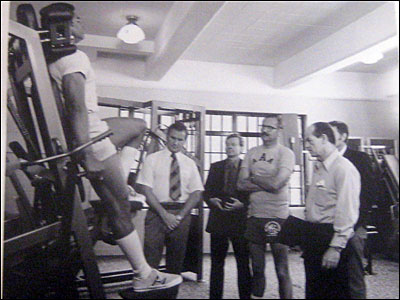
RESULTS
Strength Training
In the past twenty years, coaches, athletes, and physical educators have been increasingly aware of the role of strength in sport and athletic performance. Unfortunately, there are still many unknown factors regarding the acquisition and maintenance of strength. (Strength may generally be defined as the muscular force exerted against movable and immovable objects). An overview of the considerable volume of literature devoted to the topic reveals a wide disparity in identifying the proper way to train and the consequences of such training. “Project Total Conditioning” was designed to provide a solution to some of the enigmas associated with strength training. Two of the most widely debated aspects of strength-training concern the intensity of training which is necessary to achieve maximum results and the length of time which should be devoted to training. In the present study, nineteen subjects trained three days a week on alternate days, with a two day rest after the third workout, for a period of 8 weeks. Contrary to traditional practices (and / or misconceptions) each workout was relatively brief in duration. Each subject was required to move from exercise to exercise with a minimum of recovery time between exercises. For all practical purposes, the intensity of the workouts was so severe that it would have been impossible to appreciably extend them. During the first workouts a few of the subjects became nauseated, but after several weeks of training, not only had such negative reactions entirely disappeared, but the average time to complete a comparable workout had been considerably shortened.
The normal workout consisted of ten basic exercises. In addition, twice a week, the wholebody group workouts included six exercises designed to strengthen the neck. Table 1 lists the exercises (along with the required equipment), which, in varying combinations, constituted the training program.
Three different ways of exercising were prescribed. In the first method, an exercise was done in normal fashion (the subject lifts and lowers the weight under his own power). In the second type of training, and exercise was performed in a negative-accentuated fashion (e.g. the subject lifts the weight with two limbs and lowers the weight using only one limb). In effect, negative-accentuated work, as opposed to “normal work”, doubles the amount of weight, which can be lowered with one extremity (arm or leg). The final (and perhaps most strenuous) way of exercising was doing exercises in a negative-only fashion. In this method experimenter personnel lifted the resistance to the contracted (concentric contraction) position for the subject who in turn was required to lower the weight at a controlled pace through the eccentric contraction phase of a muscle’s range of motion. The primary advantage of negative-only exercising is that it greatly increases the amount of resistance that an individual can handle since quite obviously an individual can lower considerably more weight than he can raise. In a program designed to exercise only in a “normal fashion,” the resistance in the eccentric phase is by definition limited to the amount of weight lifted in the concentric part of muscle contraction.
The procedures for training were explicitly objective and precisely controlled. Each subject in the wholebody group worked out at an appointed time. All training as conducted on one-to-one basis with Nautilus personnel supervising every workout. Additional feedback regarding the program was provided by outside professionals. A number of physicians, coaches, and physical educators participated in the project as “exofficio” consultants (One of the primary purposes for the participation by Nautilus personnel in “Project Total Conditioning” was to evaluate several prototype machines, which were used in the study. These “consultants” aided this cause.) A record of each workout – the exercises performed, the amount of resistance and number of repetitions for each exercise, plus any extraneous information (e.g. illness) – was kept for every subject.
The amount of resistance and number of repetitions for the initial workouts were prescribed on the basis of an arbitrary projection of what the individual could reasonably handle. This part of the study proved to be an important factor. Even though most of the 19 wholebody group members had been working out with weights just prior to the start of the project, each subject developed severe muscular soreness after the first workout. In most cases, the soreness was dissipated by the forth workout. After the first week of training, the workout program was adjusted on the basis of an individual’s demonstrated performance.
Having developed the basic parameters of how to proceed with the study, the only major task remaining concerned how to accurately measure changes in strength, which
would result from the training. This measurement presented several problems. Even though strength is frequently identified as a basic component of physical fitness by both physicians and physical educators and is accepted by most coaches and athletes as an essential factor in athletic performance, the precise determination or expression of muscular strength is extremely difficult because of the variety of conditions which can effect such a determination. Perhaps the two most dominant of these conditions are: 1) the mechanical advantage produced by the body’s system of levers, and 2) the influence of neurological factors. First of all, since all contractions express their forces through the movement of skeletal levers, the end product is a measurement of movement of force (or torque) rather than force per se. As a result, the position of levers involved in a specific exercise becomes important. Angle of attachment effects both the strength of a muscle and its resultant mechanical advantage. To offer a basic example of this, all other factors being equal, and individual weigh relatively short arms can biceps-curl more resistance than a man with longer arms because of his mechanical (angular) advantage.
A second complicating factor in strength measurements evolves from the fact muscles respond to stimulation from the nervous system. As a result, maximum volitional strength is greatly affected by neurological factors (The term “neurological factors” also includes “psychological factors,” such as motivation. Collectively, members of the Corps of Cadets are a motivated and disciplined group. The objectivity of the assessment that the subjects were motivated was also strongly supported by the outside individuals who were contracted to do the ergometer testing. Refer to the CARDOVASCULAR FITNESS section in this article for additional information).Unfortunately, no one has been able to precisely identify or quantify the influence of these factors. The literature, however, suggests several viable alternatives. If a reasonable amount of training is allotted for initial learning effect (as was done in Project Total Conditioning”), absolute strength can be measured by the use of a device known as a tensiometer. On the other hand if tensiometers are unavailable, relative strength changes can be inferred from the ability of an individual to lift an increased amount of resistance the approximate same number of times for any given exercise. Other plausible methods for inferring strength increase concern quantifying the amount of lean muscle mass in an individual and measuring an individual’s ability to perform on a functional item which involves strength (e.g. leg power) In an attempt to provide a maximum amount of information on the consequences of the Nautilus strength training, Project Total Conditioning incorporated each of the four alternatives as a means to identify strength changes.
Table 2 A comparison of the 1st and 17th workouts of the wholebody group subjects
| Subject (a) | Avg. Wt. (10 exercises) | Avg. No. of Reps | Duration (b) (in Min) | Ave Wt (10 exercises) | Avg. No. of Reps | Durations (in Min) | Avg. Wt. (in lbs) | Change
(%) |
| 1 | 99.0 | 9.3 | NA | 168.0 | 10.4 | NA | 69.0 | 69.70 |
| 2 | 80.5 | 6.7 | 49 | 135.5 | 9.2 | 25 | 55.0 | 68.32 |
| 3 | 96.5 | 7.8 | 42 | 160.5 | 8.3 | 27 | 64.0 | 66.32 |
| 4 | 93.0 | 8.0 | 43 | 154.0 | 8.9 | 22 | 61.0 | 65.59 |
| 5 | 80.5 | 9.3 | NA | 132.0 | 9.2 | NA | 51.5 | 63.98 |
| 6 | 91.5 | 7.3 | 29 | 149.0 | 8.7 | 21 | 57.5 | 62.77 |
| 7 | 98.5 | 11.0 | 33 | 157.5 | 8.8 | 30 | 59.0 | 59.90 |
| 8 | 101.0 | 9.7 | 44.5 | 161.5 | 10.7 | 35 | 60.5 | 59.90 |
| 9 | 98.0 | 10.5 | 33 | 156.5 | 10.8 | 30 | 58.5 | 59.69 |
| 10 | 95.0 | 9.7 | 33 | 150.5 | 8.7 | 38 | 55.5 | 58.42 |
| 11 | 94.0 | 7.9 | NA | 147.5 | 10.0 | NA | 53.5 | 56.91 |
| 12 | 101.5 | 7.3 | NA | 159.0 | 8.2 | NA | 57.5 | 56.65 |
| 13 | 88.5 | 9.2 | 35 | 137.5 | 9.0 | 29 | 49.0 | 55.37 |
| 14 | 89.5 | 13.7 | 34 | 138.5 | 11.4 | 30 | 49.0 | 54.75 |
| 15 | 94.0 | 8.2 | NA | 142.0 | 9.0 | NA | 48.0 | 51.06 |
| 16 | 104.5 | 86 | NA | 157.0 | 10.4 | NA | 52.5 | 50.24 |
| 17 | 97.0 | 9.8 | 40 | 144.0 | 10.8 | 28 | 47 | 48.50 |
| 18 | 85.0 | 9.1 | NA | 124.5 | 11.5 | NA | 39 | 45.61 |
| Mean = | 93.78 | 9.06 | 37.73 | 148.61 | 9.67 | 28.64 | 54.83 | 58.54 |
a. Arranged in rank order by achieved percentage of improvement. Only 18 subjects are listed even though 19 participated in the study because one subject was injured during football practice and was subsequently excused from some exercises.
b. Rounded off the nearest half minute. N.A. is used to designate those for whom no recording of the duration of their workout is available.
c. The 17th workout was the last workout. The 18th workout was omitted because of scheduling problems.
d. Subject’s #10 and #14 pre-scores are based on workout #3. Both were recovering from injuries suffered at spring football practice and did not engage in the program used for the 17th workout until the 3rd workout.
Table 3. A comparison of the 2nd and 16th workouts of the wholebody group subjects. (a)
| Subject (a) | Ave Wt.
(10
exercises) | Ave No.
of Reps | Duration
(b) (in
Min) | Ave Wt
(10
exercises) | Ave No.
of Reps | Duration (in
Min) | Ave Wt.
(in lbs) | Change
(%) |
| 1 | 60.3 | 9.4 | 26 | 96.0 | 14.6 | 25 | 35.7 | 59.20 |
| 2 | 75.5 | 14.4 | 31 | 114.0 | 12.1 | 23.5 | 38.5 | 50.99 |
| 3 | 74.5 | 13.0 | 36 | 112.3 | 13.7 | 34 | 37.8 | 50.74 |
| 4 | 68.5 | 11.9 | 31 | 103.0 | 12.3 | 21.5 | 34.5 | 50.36 |
| 5 | 78.5 | 13.3 | 23 | 115.8 | 13.6 | 23 | 37.3 | 47.52 |
| 6 | 72.0 | 11.9 | 30 | 105.5 | 12.4 | 24 | 33.5 | 46.53 |
| 7 | 75.0 | 10.7 | 37 | 109.3 | 13.7 | 31 | 34.3 | 45.73 |
| 8 | 72.5 | 13.3 | 35 | 103.0 | 12.2 | 23 | 30.5 | 42.07 |
| 9 | 61.5 | 9.4 | 21 | 87.3 | 13.3 | 26 | 25.8 | 41.95 |
| 10 | 66.5 | 13.3 | 26 | 94.0 | 13.2 | 22.5 | 27.5 | 41.35 |
| 11 | 77.5 | 21.5 | 44 | 109.0 | 12.2 | 22 | 31.5 | 40.65 |
| 12 | 71.3 | 12.9 | 25 | 100.0 | 10.5 | 20 | 28.7 | 40.25 |
| 13 | 80.3 | 11.8 | NA | 112.0 | 13.1 | NA | 31.7 | 39.48 |
| 14 | 71.3 | 10.7 | 24 | 99.0 | 11.5 | 18 | 27.7 | 38.85 |
| 15 | 76.5 | 16.9 | 33 | 106.0 | 15.5 | 28 | 29.5 | 38.56 |
| 16 | 72.5 | 10.6 | 34 | 97.5 | 10.7 | 38 | 25.0 | 34.48 |
| 17 | 82.3 | 10.9 | 23 | 110.3 | 10.6 | 19 | 28.0 | 34.02 |
| 18 | 72.5 | 9.1 | 23.5 | 96.0 | 11.7 | 19 | 23.5 | 32.41 |
| Mean = | 72.7 | 12.5 | 27.92 | 103.9 | 12.6 | 23.19 | 31.2 | 43.06 |
a. The program used for the 2nd and 16th workouts differed from the one prescribed for the 1st and 17th days of training.
b. Subject #11’s data for the 2nd workout is based on his 4th workout. He did not participate in the program used for the 16th workout until #4 because of training.
A series of tensiometers (involving the major muscle groups of the body) was developed. Tensiometers are instruments which measure the force an individual can exert at a specific point in the range of motion. By means of an attached dynamometer, the force (pressure) an individual exerts against a static resistance is quantified. Six machines – each designed to be compatible with the movement required in a Nautilus machine of a comparable function – were used: 1) Bench Press; 2) Leg Extension; 3) Leg Curl; 4) Hip and Back; 5) Biceps Curl; and 6) One for the four basic functions of the neck. While the mechanical advantage offered by a tensiometer set at a fixed position might vary slightly from individual to individual. It would not change for the individual himself. In the other words, although one subject might have a slightly more disadvantageous angle of rotation than another on a specific tensiometer, the resultant pre – post-measurements reflect valid change since the angle remains constant from test to test for each individual. Unfortunately, although steps were taken to insure repeatability on the tensiomenter measuring, numerous operational problems were encountered regarding the use of these machines. Except for the information furnished by the neck tensiomenter, the data provided by the tensiomenters was inaccurate and was subsequently discarded.
Although reliable tensiometer measurements were not obtained in some cases, it is still possible to observe the strength increases which were produced by the training. Tables 2 and 3 illustrate the significant nature of these changes. By comparing the average amount of resistance that an individual used for identical (identical with respect to the exercises performed, the order of the exercises, and the relative intensity of the workout) workouts – one at the beginning of the training, the other at the conclusion of the 8 week period – the difference can logically be attributed to a change in strength. Such a conclusion can be given additional credence when the 2 weeks of training which were allocated to “learning”, are considered.
Over a period of 6 weeks, the 18 wholebody subjects increased the amount of resistance used in their first two workouts (comparisons were only made of the 1st and 17th, 2nd and 16th workouts because of spatial reasons and because they were among the few times that an exact workout was repeated) of the training by an average of 58.54% and 43.06% respectively. The variance in the amount of change incurred by the two “two” sets of workouts (15.48%) can primarily be attributed to differences in the programs used for the first and second days of training. The program for the 1st and 17th workouts included one set of each of the following exercises: squat, hip and back, leg curl, pullover, chins, dips, omni bench, torso arm, double chest, and decline press. In the 2nd and 16th workouts, set of the leg extension, leg press, seated press, duo-poly curl, and duopoly triceps was substituted for the squat, chins, dips, double chest, and decline press exercises.
Despite the dramatic changes achieved by even the lowest man (improvementwise), there were circumstances attendant to the project which undoubtedly prevented even greater levels of improvement. During the first 4 weeks of training for record, each subject participated in spring football practice. Quite possibly, the energy expenditure for spring practice not only minimized some of the gains produced by the strength training but also precluded additional increases by limiting the amount of rest (and resultant recovery ability) available to each man. Further demands on the time and energies of each subject were incurred by the final academic exam schedule, which was held concurrent with the last week of training. In addition, a few subjects missed several workouts (or trained at less than full effort) because of minor injuries or illnesses. One subject contracted the mumps but remained in the project anyway. His missing three full workouts undoubtedly accounts for his comparatively poor showing among the wholebody group members (he ranked last on the 1st/17th comparison and 10th on the other).
An examination of tables 2 and 3 reveals another meaningful statistic: the subjects, not only significantly increased their level of strength, but decreased the time required to go through an identical workout. Despite a slight increase in the number of average repetitions performed each workout, the duration of the training dropped over 9 minutes and 4.5 minutes respectively from the expended times for the initial two periods. The nine-minute decrease might have been even larger.
By the 17th workout, all of the subjects had to put on a device, which would accommodate additional weight for both the chins and the dips. In the initial workout this strap was not needed. When the fact that the entire 6 week program involved less than 8.5 hours of actual training per man is considered, the significant increases in strength and decreases in the duration of the workouts appear to be even more note worthy. In order to provide a measure of the functional application of the training, three items were administered to each member of both the wholebody and the control groups: 2-mile run (wind, stamina), 40-yard dash (speed), and vertical jump (leg power). These items were chosen because of their somewhat universal acceptance (by football coaches) as integral components of the skills required to play football. Table 4 illustrates that on each of the three measures, the wholebody group subjects improved their performance MORE than did the control group members.
The differences between the two groups on the functional items were substantial. The wholebody subject’s level of improvement was more than four times that achieved by members of the control group on both the 2-mile run (4.32 x) and the vertical jump (4.57 x). On the 40-yard dash the wholebody group improved 1.89 times the rate of the control group. The significant increase produced in vertical jumping ability is consistent with the gains achieved in leg strength by the wholebody subjects. The dramatic changes which occurred over a period of only 6 weeks in the 2-mile run times will be examined in greater detail in the section on cardiovascular fitness. One final point to consider in this section concerns the relatively moderate degree of improvement in the times for the 40-yard dash. This occurrence can be at least partially attributed to the fact that prior to the advent of training, members of both groups used the 40-yard dash as an integral part of their conditioning program to prepare for spring football practice. Once “Project Total Conditioning” and spring practice began, this specificity training (doing 40 yard dashes) by-and-large ended.

Neck Strengthening
In light of the overwhelming number of neck injuries which result from athletic competition, it is essential that both coaches and athletes undertake steps to strengthen the musculature of the neck (and surrounding shoulder area). All individuals who participate in sports which involve forceful displacement and contact of either the head or the neck should include neck strengthening exercise as an integral par the there conditioning program. Unfortunately. In many strength training programs, this aspect of self improvement has been accorded (at best) minimal attention. In fact, the two most apparent overriding commonalities which can be identified as existing between the “traditional” methods of strengthening the neck – calisthenic-type exercises such as bridging, the buddy system of exercising (one individual pushes against a resistance provided by someone else); and the use of external paraphernalia, such as harness straps which accommodate free weights, etc. are: 1) Such methods generally are very awkward and as a result, inhibit proper form; and 2) These “programs” typically produce less than desired-for results.
In “Project Total Conditioning,” efforts were made to minimize the first aforementioned limitations, thereby abrogating the second concern. Three machines – each designed to enable an individual to exercise the neck in proper form for the basic functions of the neck – were used. For comparative purposes, the subjects who participated in this part of the study were placed into three groups (all of the subjects who were part of this section were members of the intercollegiate football team). The first group consisted of the 19 wholebody subjects discussed in the previous section. In two of their three weekly workouts, these individuals included exercises for strengthening their necks. The second group was designated as the “neck-only” group because the sixteen individuals in the bracket restricted their strength training to the muscles of the neck and shoulders. The last group was comprised of 14 members who served as a “control” group. Subjects in the control group did not participate in the training conducted during the project. Any exercising these individuals did was done either on their own or under the auspices of the USMA football staff.
Table 4 A comparison of wholebody group vs control group performance on 3 functional measures
| Two Mile Run (a) | Pre Training (in min) | Post-Training (in min) | Mean Difference (in sec) | Improvement (%) |
Wholebody
Group (N=19) | 13:18 | 11:50 | 88 | 11.02 |
Control Group
(N=15) | 13:04 | 12:44 | 20 | 2.55 |
| Forty Yard Dash (b) | Pre Training (in min) | Pre Training (in min) | Mean Difference (in sec) | Improvement (%) |
Wholebody
Group (N=19) | 5.1467 | 5.0933 | 0.0534 | 1.04 |
Control Group
(N=15) | 4.7933 | 4.7667 | 0.0266 | 0.55 |
| Vertical Jump (c) | Pre Training (in inches) | Pre Training (in inches) | Mean Difference | Improvement (%) |
Wholebody
Group (N=19) | 22.600 | 24.067 | 1.467 | 6.49 |
Control Group
(N=15) | 21.692 | 22.000 | 0.308 | 1.42 |
A. Run on a tartan, indoor track.
B. Best of one trial, run in tennis shoes administered in the gymnasium.
C. Best of three trials, one hand reach.
| Tensiometer Strength (b) | Pre Training | Post-Training | Mean
Difference | Improvement (%) |
| Wholebody Group (N=19) | 586.28 | 1,125.16 | 538.88 | 91.92 |
| Neck-Only Group (N=16) | 571.06 | 894.94 | 323.88 | 56.72 |
| Control Group (N=16) | 620.50 | 793.25 | 172.75 | 27.84 |
| Neck Circumference (c) | Pre Training (in inches) | Post-Training (in inches) | Mean Difference (in inches) | Improvement (%) |
| Wholebody Group (N=19) | 16.38 | 16.82 | +0.44 | 2.67 |
| Neck-Only Group (N=16) | 16.28 | 17.03 | +0.75 | 4.61 |
| Control Group (N=14) | 16.47 | 16.62 | +0.15 | 0.91 |
a. The pre- post-test data on the average amount lifted and number of repetitions performed is not presented because the neck-only group subjects trained in a semi-supervised environment. As such, their recorded number of properly performed repetitions could, in some instances, be inaccurate.
b. The totals reflect the sum of four tensiometer measurements –one each for extension, flexion, lateral flexion – left, and lateral flexion – right. The scores on one of the wholebody subjects were omitted because he was sick on the day the testing was conducted.
c. No pre-training measurements were taken for two control group subjects.
The program for strengthening the neck consisted of three weekly workouts for the neck-only group and two neck sessions for the wholebody subjects. One basic program was used for all neck-training workouts. This program required each subject to perform one set of six exercises: shoulder shrug, neck rotation (rotary neck), and the exercises done on the 4-way neck machine (flexion, extension, lateral flexion-right, and lateral flexion-left). When an individual was able to do 12 repetitions of an exercise, except for the rotary neck, which remained constant at 12 repetitions (six each direction), the amount of resistance was increased to the next higher increment. Each participant took approximately 8 minutes to complete a “neck” workout during the initial stages and less than seven minutes thereafter.
Similar to the procedures discussed in the section on the wholebody strength training, the first 2 weeks of exercising were devoted to the “learning effect.” Trainingfor-
record started at the sixth workout. Table 5 presents the between group differences, which resulted from 6 weeks of training.
The subjects in both the whole body and the neck-only groups increase their relative neck strength (91.92% and 56.72% respectively) at a greater level than did the control group members (27.84%). These significant changes are even more substantial when the fact that they were achieved in approximately two hours of actual training is considered. The large variance between the results achieved by the wholebody and the neck-only groups is at least partially attributable to the amount of supervision of each group received during training. The wholebody group was closely supervised at all times, insuring that each subject performed every repetition in proper form. As a concession to experimenter manpower requirements and in an attempt to ascertain (to at least a peripheral degree) the influence of experimenter supervision, the neck-only subjects received only minimal input from an instructor during their actual training. Their progress and form were monitored and charted, but only on infrequent occasions were the neck-only subjects “pushed” to the apparent limit of their capabilities by an experimenter. The improvement attained by the control group members is the result of an combination of the effects of engaging in spring football practice with its attendant “involvement” of the neck and lifting on their own initiative.
The neck circumference results are somewhat more difficult to evaluate. By any rational criterion, the subjects who participated in the Nautilus training increased the size of their necks by a significant degree. However, the direction of the variance between the wholebody and the neck-only groups is inconsistent with both the tensiometer measurements and the personal observations of those personnel involved with “Project Total Conditioning.” By all reasonable expectations, the neck of each of the whole-body should have increased in size substantially more than those of the neck-only group. The recorded differences are apparently the result of operational complications. The same individuals did not measure the necks of the wholebody subjects who calculated the neck-only and control group figures. In addition, a slightly different measuring instrument was used to obtain the whole body data. Complicating the dilemma was the fact that the wholebody circumference measurements were not available for analysis until after the product had been completed. While the neck-only and control group measurements were conducted by Academy personnel, the responsibility of securing the whole body group calculations was assigned to outside personnel who were involved with another aspect of the project.
A few wholebody subjects were measured DURING the course of the 6 weeks of training by the same individuals who conducted the testing of the other groups. In EVERY single case, the resultant measurements of the wholebody subjects indicated that the AVERAGE increase in neck circumference for the nineteen wholebody group members would exceed at least one inch by the end of the training (similar operational problems occurred during the measurement of skin fold thickness and body fat percentages. In the case of skin-fold data, however, calculations on each member of ALL three groups were obtained by the same experimenter). Although the existing discrepancies in the circumference data cannot be resolved, the unabated fact remains that significant increases in neck strength were produced by both the wholebody and the neck-only group training.
Cardiovascular Fitness
Cardiovascular fitness is an integral component of both an individual’s level of overall physical fitness and individual’s capability for sustained athletic performance. A brief review of the basic function of the circulatory system can clarify these basic assumptions. The primary function of the circulatory system may be stated in one simple word – “transport.” It transports essential like oxygen and glucose to the cells, and byproducts, such as carbon dioxide, from the cells. As would be expected, the circulatory system is called upon to increase its transport of essentials to the cells and of waste products from the cells during muscular exertion. This need, of course, is directly related to the intensity and duration of exertion. It follows that one of the limiting factors in athletics and sport is the ability of this system to meet the demands imposed by the body during competition. Therefore two of the benefits which can be derived from a functionally efficient circulatory system are an improved capacity for work (exercise) and an increased ability to perform the transport function.
Traditionally, physicians and exercise physiologists have held that participation in strength training does not increase an individual’s capacity to meet the “transport” (oxygen-in –CO2-out) requirement of strenuous exercise. Although this capacity is collectively known by various names, this section refers to it by one of its most common designations- “cardiovascular (C.V.) fitness” (cardio refers to the “heart” and the vascular portion consists of the large arteries, the small arteries, the arterioles leading to the tissues, and the capillaries within the tissues). Numerous researches have found that the individual who wishes to improve his C.V. capacity by means of an exercise program must incorporate several factors into his efforts. The program must be of sufficient intensity to have the heart rate of the participant reach a level of at least 145-150 beats per minute (in general, the more of the body’s large musculature involved in the exercise, the easier it will be to reach a heart rate of 145-150 beats per minute); this rate should be sustained for a minimum of 10-12 minutes; and the participant should engage in such exercising 3-4 times a week (the literature is equivocal on the exact number of times).
Conventional strength training practices have prevented C.V. improvement from occurring because even on those occasions when a sufficiently higher heart rate higher heart rate is attained by a participant, such a rate is typically not sustained for more than a brief period. In the present study, an attempt was made to train the wholebody subjects in such a manner that improvement in their overall level of cardiovascular fitness would occure. By limiting the rest period between the exercises to a few seconds and by preventing the subjects from resting during the actual training, a high degree of intensity was achieved and maintained for the duration of the workout.
In order to ascertain the effects of the training, several tests were administered on a pre-post-training basis – to both the wholebody and the control group members. Differences on the initials test date were determined by a T-test for each variable. If there were no initial significant differences, then the T-test was applied to the post-training data to determine the effects of the training. If there were significant differences on the initial data, then analysis of covariance was used to determine the relative degree of any changes which occurred between the two groups as a result of the training.
Three different states of the cardiovascular function were examined: 1) C.V. capacity at rest; 2) Responses to sub-maximal work; and 3) responses to maximal work. The tests for the resting state consisted of measuring each subjects heart rate (HR), systolic (blood is being forced out of the heart), blood pressure (SBP), diastolic (the chambers of the heart are filing with blood), blood pressure (DBP), and systolic tension time index – an accepted measure of coronary circulation which is calculated by multiplying heart rate x systolic blood pressure (STTI).
An evaluation of the effects on the sub-maximal state was achieved by having each subject perform on a bodyguard model 990-bicycle ergometer. An ergometer is a basic research instrument which allows a subject to pedal against a resistance (load) which can be predetermined and adjusted (when necessary) by the experimenter. The sub-maximal tests required each subject to perform a continuous, progressive ergometer ride with increasing work loads (360 kpm/min increase) every two minutes until the subject could no longer sustain the rate (60 rpm) or wanted to stop. This was followed by two minutes at the initial light load (360 kpm/min), then three minutes of rest. At each condition, the HR, SBP, DBP, SITTI, and a subjective rating (by the subject) of his perceived exertion (RPE) were obtained. Cardiac feedback was provided by means of a continuous EKG which was obtained on each subject while on the ergometer. The maximal state was evaluated by means of two measures: total riding time and 2-mile run performance (with the exception of administering the 2-mile run test, all cardiovascular testing was conducted by outside consultants. In light of the fact that these individuals were not informed until after all testing had been completed about which subjects were a member of which group – control or wholebody, their efforts can be accorded an additional degree of legitimacy).
The results of the testing were conclusive. On NONE of the 60 indices purporting to evaluate the effects of the training on the cardiovascular function was the control group better on the final testing period (or on the change from initial to final) than the wholebody group. The following significant differences (.05 level) were caused by the training afforded to the wholebody group: Lower HR at 360, 1080,1260,1620, and 1800 kpm/min; lower SITTI at 360, and RPE at 1260; a higher amount of work necessary before the subject achieved a heart rate of 170; a longer ride time; and a lower time required to run 2 miles. These calculations mean that the training caused the players to work more efficiently (lower HR) at light, moderate and near maximal levels. They could also do more work before reaching a heart rate of 170, as well as more total work. Their improvement in their 2-mile run performances also indicates that they were less stressed at maximal levels. For the coach and the athlete, the implication is clear: these subjects could perform at more efficient rate for a longer period of time. In the athletic arena, where contest are frequently decided by inches or other fractions, such training could play an important role.
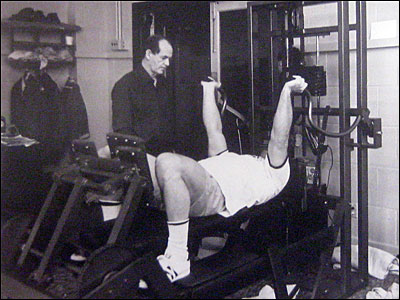
Flexibility
In any examination of the factors that effect human physical performance, consideration must be given to flexibility. Basically, flexibility can be defines as the degree to which a joint is free to move throughout its normal range of motion. The primary determinant in flexibility is the musculature surrounding a specific joint. If the muscles and tendons encircling a joint are required on a regular basis to stretch – to elongate – through a normal range of motion, the joint will maintain a normal level of flexibility. On the other hand, when the muscles surrounding a joint are not regularly required to make normal range adjustments, a shortening of that musculature will develop, and a loss of flexibility will occur.
The fear that “tightened” muscles result in a lack of flexibility undoubtedly accounts for mush of the superstition and misconception regarding the relationships between strength training and flexibility. Many coaches and athletes have not adopted strength training into their conditioning programs because of an erroneous belief that all such training will result in the participant becoming “muscle-bound.” The assumption is made by these individuals that if a person has bulging muscles, he must have sacrifices some degree of flexibility. The truth of the matter is that, with proper training methods, normal flexibility will not only be uneffected, but may be increased by strength training.
When planning a program the principles that should be considered are: 1) for each exercise, a muscle should be stretched through a full range of motion; and 2) both the agonist and the antagonist should receive comparable attention in any strength program. Muscles are set up in opposing pairs around joints. In a discussion of elbow flexion, for example, the biceps is the agonist, or the muscles responsible for the action being considered. The triceps, which in this case would be the muscle “opposing” this action, is called the antagonist. These designations are solely based on the specific joint movement being considered. If, however, attention was focused on elbow extension rather than on flexion, the triceps would be referred to as the agonist and the biceps as the antagonist. In order to avoid a loss in flexibility, strength training programs should be balanced to give equitable attention to the development of both the antagonists and the agonists of a particular muscle group.
In “Project Total Conditioning,” steps were undertaken to comply with both principles. By design, the machines required each subject to both fully stretched perform each exercise through normal range of motion. In addition, the workouts were planned to give an appropriate amount of attention to each of the agonist-antagonist pairs of the
major muscle groups.
The procedures for examining the effects of the training on flexibility were similar to those discussed in earlier sections of this article. Because of their potential import for human (and in particular, athletic) performance, four measures of flexibility – trunk extension, trunk flexion, shoulder extension, and shoulder flexion – were selected for examination. Subjects in both the wholebody and the control groups were tested on a pre and post-training basis on each of the four items. The relative degree of changes on the four items over the 6-week period of the study provides the basis for identifying the effects of the training.
Table 6 illustrates the fact that the training produced significant changes in flexibility. On each of the tested measures, the wholebody group achieved a substantially higher degree of improvement than did the control group (only the results from three flexibility measures are presented in Table 7; the data on the shoulder flexion was obtained through the coordinated use of synchronized photography and a goniometer (an instrument to measure the degree of angle) and was not available at the press time for this article).
The results provide formidable support for the contention that strength training, when properly performed, can in fact increase flexibility. In a period of only 6 weeks, the wholebody group subjects improved on the three flexibility measures by an average of almost 11% (10.92) In contrast, the average gain in flexibility for the control group members was less than 1% (0.85).
Body Composition
Body fat is accepted by researchers as the major storage form of energy. On the other hand, there have been a number of studies, which indicate that excessive body fat can have a debilitating effect on human performance, individual health, and psychological well-being. For the athlete, unwanted body fat serves as an unneeded obstacle, which can hinder his competitive efforts.
There is an abundances of evidence to support the conclusion that in order to reduce fat, it is necessary to expend more calories than are consumed. Traditionally, strength training has not been considered to be an activity which would greatly facilitate such a “negative calorie balance.” In “Project Total Conditioning,” steps were undertaken to identify the effects of high-intensity, brief duration training on body fat measurements. Two types of body fat calculations were obtained. A relative percentage of body fat for each subject as determined by a machine known as the Whole Body Counter and skinfold measurements.
Prior to the first workout of training-for-record and at the conclusion of the 6 week study, the wholebody group (the prohibitive costs prevented the inclusion of the control group) was flown to Rochester, New York. At the University of Rochester Medical School, the relative level of lean body mass (muscle) and the body fat for each of the nineteen subjects was determined by means of the Whole Body Counter. By measuring the radiation given off potassium K in the body, the Whole Body Counter is able to provide an estimation of body fat. Table 7 presents the results.
Contrary to expectation, only eight out of nineteen subjects lowered the overall level of body fat. In fact, the group as a whole averaged a slight increase in the amount of body fat. These calculations are in contradiction to both what might have been anticipated as the result of significant strength increases and to a visual interpolation of pre- and post-training photographs of the subjects (in only their gym shorts). Two possible sources of inaccuracy in the data are the 4% potential error inherent in the machine (as reported by the Rochester personnel) and the fact that the pre- and posttesting was conducted by two different sets of individuals.
A second source of anthropometric input was provided by fat-caliper measurements. Commonly referred to as skin-fold test, these measurements are an accepted (although not entirely reliable) method of quantifying the relative amount of fat in the body. By measuring the thickness of specific areas of the body a comparing the change in thickness on a pre- post-treatment basis, the effect of the training on the body fat can be identified.
In “Project Total Conditioning,” two sets of skin-fold measurements were obtained. In the first, the Rochester personnel provided fat calipher measurements of the nineteen wholebody group subjects. In the second set, USMA personnel measured both the wholebody and the control group members. Table 8 presents the results.
Again the calculations are contradictory. The Rochester measurements showed a slight overall increase on the skin-fold test, while the USMA calculations indicated a substantial decrease for both groups. On the USMA measurements, the wholebody group improved slightly better (19.4%) than did the control group (18.5%)
Table 6. A comparison of the effects of training on flexibility
| Trunk Extension | Pre-Training (in inches) | Post-Training (in inches) | Mean Difference (in inches) | Improvement (%) |
| Wholebody Group (N=18) | 46.33 | 53.55 | 7.22 | 15.58 |
| Control Group (N=16) | 47.44 | 48.06 | 0.62 | 1.31 |
| Shoulder Flexion | Pre-Training (in inches) | Post-Training (in inches) | Mean Difference (in inches) | Improvement (%) |
| Wholebody Group (N=18) | 47.33 | 52.83 | 5.50 | 11.62 |
| Control Group (N=15 ) (a) | 50.75 | 51.25 | 0.50 | 0.99 |
| Trunk Flexion | Pre-Training (in inches) | Post-Training (in inches) | Mean Difference (in inches) | Improvement (%) |
| Wholebody Group (N=18) | 47.94 | 50.61 | 2.67 | 5.57 |
| Control Group (N=16) | 50.50 | 50.63 | 0.13 | 0.26 |
a. One control group subject was omitted because of a shoulder injury.
Table 7. A comparison of the effects of training on the wholebody subject’s level of lean muscle mass and body fat
| Lean Body Mass (in lbs) | Body Fat (in lbs) | Fat (%) |
| Pre-Training (N=19) | 182.34 | 26.48 | 12.4 |
| Post-Training (N=19) | 180.48 | 27.50 | 13.0 |
| Mean Difference | -1.86 | +1.02 | 0.6 |
Table 8. Fat calipher measurements for subjects involved in “Project Total Conditioning” (a)
| Rochester (B) | | | USMA (C) | | |
| Pre-Training | Post-Training | Mean Difference | Pre-Training | Post-Training | Mean Difference |
| Wholebody Group (N=19) | 9.97 | 10.42 | +0.45 | 6.25 | 5.04 | -1.21 |
| Control Group (N=10) | NA | NA | NA | 6.48 | 5.31 | -1.17 |
a. All measurements are in millimeters.
b. The Rochester data is base on an average of five measurements: biceps, subcostal, umbilical, iliac, and subscapular.
c. The USMA data is based on an average of several areas: chest, axilla, triceps, subscapular, abdomen, supralliac, and frontal thigh.
Table 9. A comparison of the effects of a program using a Super Hip and Back Machine versus one using a DUOsymmertic POLYcontractile Hip and Back Machine
| Vertical Jumping Ability | Pre-Training (in inches) | Post-Training (in inches) | Mean Difference (in inches) | Improvement (%) |
| Regular Hip and Back | 22.222 | 22.722 | 0.50 | 2.25 |
| DUO – POLY Hip and Back | 21.45 | 22.86 | 1.41 | 6.57 |
Thermographic Diagnosis
As an aside to the main areas of concern under investigation in “Project Total Conditioning,” an effort was undertaken to evaluate the potential application of thermography to strength training. Basically, thermography is a procedure where skin temperature readings are visually obtained by means of a scanning camera and a display unit. In the past, thermography has been primarily concerned with various aspects of early breast cancer detection. Most thermographic instruments are still chiefly engages in that application. However, the thermographic potential in medical diagnosis is apparently quite diverse and particularly promising in the field of orthopedics and peripheral circulation. Given that skin temperature recordings are representative of the circulatory situation in the examined tissues, the use of thermography may have many uses in the field of athletics.
In the present study, a consultant from AGA Corporation, the largest supplier of thermographic instruments in the world, was employed to visually record several workouts. At press time for this article, and analysis of this efforts and the implications of his findings has not been completed.
Concurrent Studies
Two secondary studies were also conducted as part of “Project Total Conditioning.” Lasting only four weeks, each investigative effort attempted to provide additional information concerning strength training and practices and processes. In the first study twenty-four rugby team members participated in a project designed to examine the effects on overall neck strength of a twice weekly versus a three-times-a-week workout program. The content of the program (exercises, equipment, etc.) was the same as the one discussed in the section on neck strengthening. Somewhat surprisingly, the two-times-a-week program generated a slightly greater increase in neck strength (41.6%) than did the three-times-a-week (39.8%).
In the second project, twenty-two members of the USMA volleyball club team were involved in a study designed to determine the effect on their vertical jumping ability of an exercise program using the Nautilus Super Hip and Back Machine versus one, which uses the Nautilus DUPsymmetric POLYcontractile Hip and Back Machine. Both programs consisted of each subject performing one set, three times weekly, on their appropriate machine. The total amount of expended time involved less than 60 seconds per workout. Table 9 presents the results of the training.
Although both programs increased the average vertical jumping ability of the subjects, the “DUO-POLY” workout -wherein the participant lowers the weight with one leg while being forced to keep the other leg in a contracted position – produced a greater increase. Since very little has been done regarding the study of the effects of “DUOPOLY” contractions on strength training results, this finding lends impetus to the need for additional investigative efforts.
Summary
In retrospect, considering the countless hours, the substantial cost, and the effort involved, the question might be asked: what was accomplished by “Project Total Conditioning”?
First and foremost, it was demonstrated that a strength training program, when properly conducted, can have a positive effect on the central components of physical fitness. In less than 6 weeks, high-intensity training of a relatively short duration increased the average overall strength of each subject by more than 58%. Neck strength was also significantly affected. The members of the wholebody and the neck-only group increased their aggregate level of neck strength by an average of 91.9% and 56.7% respectively. Contrary to most commonly held beliefs on the subject of strength training, the training also significantly improved the cardiovascular condition of the subjects. By maintaining the intensity of the workouts at a high level and by limiting the amount of rest between exercises, the training resulted n improvement on each of 60 separate measures of cardiovascular fitness. Contrary to widespread opinion, not only will a properly conducted program of strength training produce increases in muscular strength but will also significantly improve an individual’s level of cardiovascular condition. The data suggests that some of these cardiovascular benefits apparently cannot be achieved by any other type of training. And finally, the experimental subjects increased their level of flexibility by an average of more than 10% on the three evaluative items.
In today’s society, it is impossible to find any topic on which there is a shortage of rhetoric. Certainly, strength training is no exception. Unfortunately, much of this dialog has been based on innuendo, superstition, and/or misinformation. This author feels that part of the misunderstanding has resulted from the fact that previous studies on the subject of conditioning have focused on only one or two aspects of the overall picture. For that reason many of the interrelationships of the effects of strength training have been either overlooked or misunderstood. “Project Total Conditioning” provides new insight and clarification into these interrelationships.
